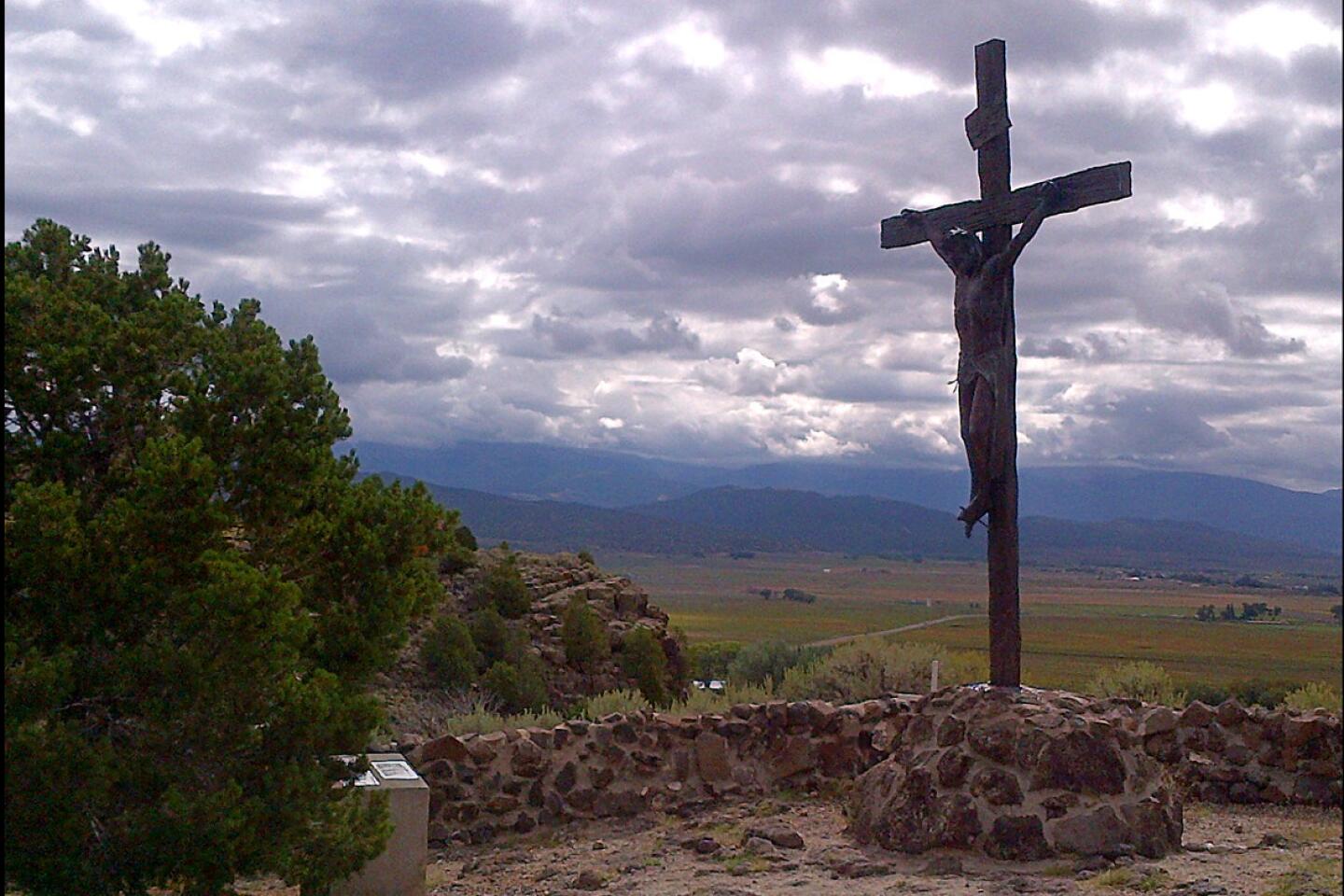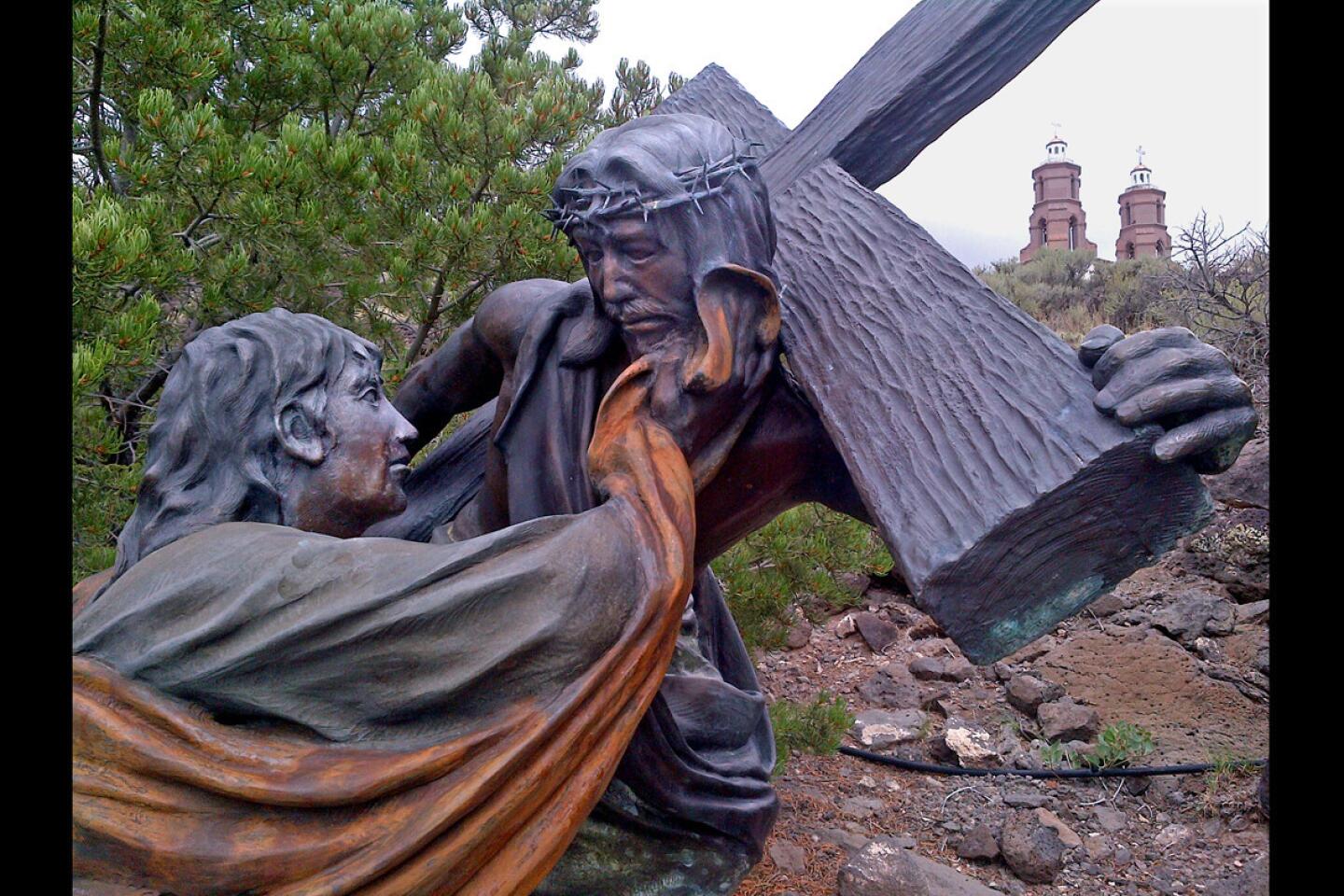Christianity and folk art in southern Colorado’s San Luis Valley
- Share via
Reporting from FORT GARLAND, Colo. — Shortly after dawn, I pulled into this tiny town and studied a mural on the side of the post office. It was more than a painting; it was an illustrated map of Los Caminos Antiguos — the Ancient Roads.
This was the fall road trip I had been looking for, something beyond mountains and golden aspens, something combining history, mystery and a bit of eccentricity.
The 129-mile route winds through an isolated swath of the San Luis Valley, traversing the beating heart of Spanish Colorado, an isolated tableau of luminous landscapes, airy plazas and profound spirituality near the New Mexico border.
And the mural pointed the way.
I headed south on Colorado Highway 159, where chaparral runs like a pale green carpet to the soaring Sangre de Cristo Mountains. The September air was crisp, the colors sharp and the trees turning red and yellow.
Half an hour later, I pulled into San Luis, the oldest town in Colorado and home to the Stations of the Cross Shrine on La Mesa de la Piedad y de la Misericordia — the Hill of Piety and Mercy.
I walked up the scrubby hillside, soon encountering a life-size Pontius Pilate, his hand dipped into a bowl of water as an accuser pointed to a downcast Jesus. The finely sculpted faces radiated cowardice, hatred and despair.
As the path grew steeper, the suffering increased. A Roman guard handed the cross to Jesus. Three women wept as their savior struggled. And finally the Crucifixion.
At the top, the sun illuminated Jesus rising from the cross, arms thrust toward the magnificent, white-domed La Capilla de Todos los Santos, or Chapel of All Saints, just a few feet away. Regardless of your faith, it was an extraordinary sight.
After exploring the chapel’s simple interior, I walked back down as a trickle of pilgrims climbed upward.
When I reached the car, I realized I’d lost my keys.
I swiftly retraced my footsteps, asking everyone I passed if they had found any keys. Then I saw them in the gravel just outside the chapel.
A woman standing nearby smiled at me.
“When you asked if I had seen any keys I said a prayer to St. Jude for you,” she said. “I used to do that all the time for my mother when she lost her keys. And now you have found them.”
I could have used a saint to help me track down Huberto Maestas, the shrine’s sculptor. No one answered at his sprawling, hacienda-like house downtown, so I loitered outside his big yellow studio until he pulled in.
Maestas, tall with a white beard, invited me into his cavernous workshop cluttered with statues of Jesus, the Virgin Mary, Native Americans and assorted wax heads.
Like others here, he grew up speaking an archaic form of Spanish the conquistadors would have recognized.
“Everyone in this valley speaks Spanish with an old Castilian accent,” he said. “We are so remote that the dialect hasn’t changed.”
Along with the Spanish language, the Catholic Church has bound the valley together since King Philip II of Spain took possession of it 400 years ago. Even so, Maestas never imagined the shrine would become a major pilgrimage site.
“Those sculptures aren’t mine anymore,” he said. “They belong to the people who visit them. It’s a living thing that has become something besides art.”
Miracle in the sky
One of the first settlers in San Luis was Dario Gallegos, who opened R&R Market in 1857, one of the oldest family-run businesses in Colorado. I met his great-great-grandson Felix Romero, 67, who now owns the store. Romero believes San Luis — and especially the shrine — has transformative powers.
“By the time you reach the last station you are so changed you come to know yourself as a thought in the mind of God,” he said.
Intrigued but baffled by that, I returned to Los Caminos Antiguos and headed west to threadbare San Acacio, where locals say a miracle once saved the town.
It happened in 1853, when a party of Utes galloped toward settlers in a pasture. The desperate men prayed to St. Acacius for deliverance, and he appeared in the sky on horseback, scaring off the raiders. The village built a church in his honor that still stands.
Religious fervor is intense here. Scattered around the back roads are empty moradas, wooden meeting houses once used by the Penitente Brotherhood known for bloody self-flagellation rituals during Lent. The church tried to suppress the practice, but it went on for years. Some say it continues today.
I motored out of San Acacio into a great blue emptiness. The sky is king here, magnifying a world of rich color and subtle beauty beneath it.
As the highway crossed the sleepy Rio Grande, I veered onto a dirt road toward Los Sauces, or the Willows.
After miles of austere landscapes, this felt like Canaan. Horses ran through autumn fields of lavender and swaying sunflowers. Shaggy green willows hung over adobe houses. A river full of rippling cattails flowed nearby.
I later caught up with Dolores Valdez de Pong, who spent much of her childhood here and co-wrote a book with her mother, Olivama Salazar de Valdez, about Los Sauces.
“Spanish tradition was strong,” she told me. “We had our own customs for burial and marriage. When someone died, they rang the church bell. The Penitentes would come to the house of the deceased and pray with the family.”
Her mother fell ill and died just weeks after the book was published. People came to her bedside for autographed copies until the end.
“So many people told me, ‘This is my story, this is my childhood,’” said Valdez de Pong.
I reluctantly left the land of the willows and continued west to Manassa, a tidy Mormon town and home to former heavyweight boxing champ Jack Dempsey, a.k.a. the Manassa Mauler. The log cabin where he was born is now a museum and a statue of Dempsey, who won the title in 1919, stands out front.
I stopped briefly in Conejos to see Our Lady of Guadalupe Catholic Church, built in 1856, and said to be the oldest parish in Colorado. The solemn interior glowed with sunbeams suffusing through green, red and blue stained glass.
A few miles south in Antonito I found another cathedral of sorts — a towering, turreted cathedral of junk called Cano’s Castle. The reclusive creator, Dominic “Cano” Espinosa, skipped the stained glass and built the place entirely of crushed beer cans, hubcaps and wire. Lest anyone mistake it for a scrap heap, a sign outside declares “Jesus Lord of Kings.”
While I was in the neighborhood I met with Michael Ito, who manages the Indiana Jones Home Bed & Breakfast, featured briefly in the movie “Indiana Jones and the Last Crusade.”
We went inside and Ito played the DVD showing the young Jones being chased into the house and forced to relinquish the Cross of Coronado.
“You lost this time, kid,” says the patronizing goon, “but that doesn’t mean you have to like it.”
Ito shut off the movie.
“And that’s Antonito’s 15 minutes of fame,” he said.
Say hello to Kit
The next day I drove north to the Fort Garland Museum in Fort Garland, where I had begun my trip.
The fort protected Spanish settlers from Indian attacks and was commanded by famed scout and soldier Kit Carson. There were exhibits of early Spanish life and mannequins of Carson and his wife, Josefa Jaramillo, in their actual living quarters.
Before ending my trip, I visited little Blanca at the foot of majestic Blanca Peak.
I stopped at Forest Tango Art Works, a studio of brilliantly colored Southwestern-style paintings, sculptures and antiques.
Owner Joyce Garcia Henrie grew up in the valley and spoke only Spanish until she was 5. She also created the mural I used as my guide for the trip.
“This valley is one of the most beautiful places in Colorado,” she said. “And there is an interesting pocket of people here.”
That was an understatement. In two days I’d experienced natural beauty, obscure history and a powerful spirituality that at times proved exhilarating.
Felix Romero was right. “The valley will change you,” he told me, “and you’ll leave with a happy heart.”
::
If you go
THE BEST WAY TO LOS CAMINOS ANTIGUOS
From LAX, United, Southwest, American and Frontier offer nonstop service to Denver; Southwest offers direct service (stop, no change of planes); and Delta, United, Southwest, US Airways and American offer connecting service (change of planes). Restricted round-trip fares begin at $388, including all taxes and fees. From LAX, American, Southwest and United offer nonstop service to Albuquerque; Southwest offers direct service; and Southwest, US Airways, American, Delta and United offer connecting service. Restricted round-trip fares begin at $370, including taxes and fees.
Los Caminos Antiguos Scenic Byway is about 129 miles long and winds around the San Luis Valley. You can start in Alamosa, Colo., and follow the route to Chama, N.M., about 167 miles from Albuquerque. Or you can design your own journey. I drove five hours from Denver to Fort Garland, where I began the trip.
WHERE TO STAY
San Luis Inn, 132 Main St., San Luis, Colo.; (719) 672-3399. Single rooms cost $75. The drive can be done in a day, but I decided to spend the night at the basic San Luis Inn. There are more accommodations in Antonito, Alamosa and Fort Garland.
TOURS
The Cumbres & Toltec Scenic Railway offers steam train rides throughout the San Luis Valley. For information on trips, go to https://www.cumbrestoltec.com.
TO LEARN MORE
There are many websites about this part of Colorado. Here are a few:
Sangres.com: https://www.sangres.com/colorado/scenic-byways/caminosantiguos.htm#.VCzXl8J0yM9
Southern Colorado Guide: https://www.southern-colorado-guide.com/los-caminos-antiguos.html
San Luis Valley Heritage: https://www.slvheritage.com/heritage-attractions/los-caminos-antiguos-scenic-historic-byway
More to Read
Sign up for The Wild
We’ll help you find the best places to hike, bike and run, as well as the perfect silent spots for meditation and yoga.
You may occasionally receive promotional content from the Los Angeles Times.








